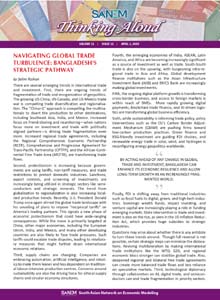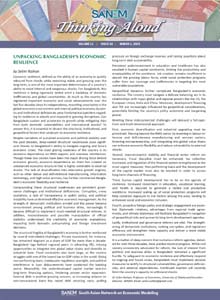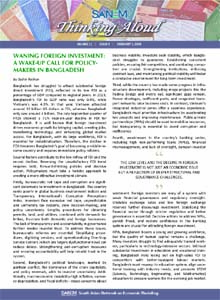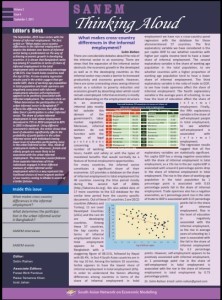
Thinking Aloud: Volume II, Issue 4
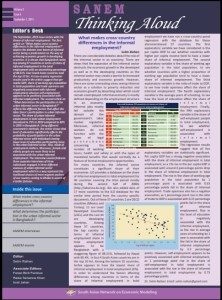 The September, 2015 issue comes with the theme of informal employment. The first article on “What makes cross-country differences in the informal employment?” depicts the debates over boom of informal sector being a predicament on the way of achieving economic growth in developing countries. It is shown that Bangladesh ranks top among 57 countries in terms of share of informal employment in the total employment with an astonishing percentage of 88.31%. Four South Asian countries lead the top 10 list. Results from a cross-country regression, used in the article, suggest that per capita GDP, share of working age population in total population and trade openness are negatively associated with informal employment whereas self-employment appears to be positively associated with informal employment. The second article on “What determines the participation in the urban informal sector in Bangladesh?” reflects the different https://www.therapyheals.ca/xanax-1mg/ factors that affect the labor force’s participation in urban informal sector. The share of urban informal employment in total urban employment decreased to 71% in 2010 compared to 82% in 2005 in Bangladesh. Using different econometric methods, the article shows that level of education significantly affects the probability of participation in the urban informal sector with individuals having lower level of education participating more in the urban informal sector. Also, mode of employment matters. Moreover, female and elderly people are more likely to be associated with the urban informal employment. The interview session features three separate interviews of three individuals engaged in three different avenues of urban informal sector employment which in a way represent the livelihood choices of most migrant workers of our country coming to Dhaka in search of a better fortune.
The September, 2015 issue comes with the theme of informal employment. The first article on “What makes cross-country differences in the informal employment?” depicts the debates over boom of informal sector being a predicament on the way of achieving economic growth in developing countries. It is shown that Bangladesh ranks top among 57 countries in terms of share of informal employment in the total employment with an astonishing percentage of 88.31%. Four South Asian countries lead the top 10 list. Results from a cross-country regression, used in the article, suggest that per capita GDP, share of working age population in total population and trade openness are negatively associated with informal employment whereas self-employment appears to be positively associated with informal employment. The second article on “What determines the participation in the urban informal sector in Bangladesh?” reflects the different https://www.therapyheals.ca/xanax-1mg/ factors that affect the labor force’s participation in urban informal sector. The share of urban informal employment in total urban employment decreased to 71% in 2010 compared to 82% in 2005 in Bangladesh. Using different econometric methods, the article shows that level of education significantly affects the probability of participation in the urban informal sector with individuals having lower level of education participating more in the urban informal sector. Also, mode of employment matters. Moreover, female and elderly people are more likely to be associated with the urban informal employment. The interview session features three separate interviews of three individuals engaged in three different avenues of urban informal sector employment which in a way represent the livelihood choices of most migrant workers of our country coming to Dhaka in search of a better fortune.
Link: Thinking-Aloud_II_N4
Tag: informal employment, south asia

